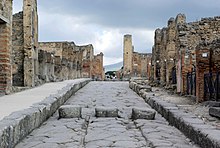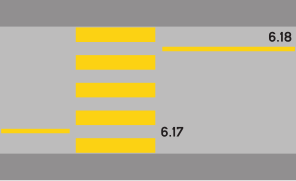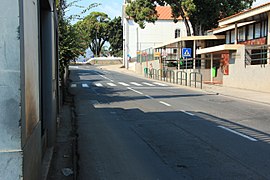In-Street Ped Crossing
The pedestrian crossing , in Germany pedestrian crossing (official abbreviation here FGÜ , formerly officially thick line chain ) or protective path in Austria or pedestrian crossing in Switzerland, is a crossing system on streets for pedestrians and wheelchair users . A pedestrian crossing is marked with the corresponding signage or traffic lights by wide lines on the roadway , which also serve as traffic signs.
The stripes are white in Germany and Austria, so these are usually colloquially referred to as zebra stripes after the similarly patterned zebras . In Switzerland the stripes are yellow, but the name zebra crossing has also become established there.
In contrast to the pedestrian overpass or pedestrian underpass, the pedestrian crossing is always at ground level.
Since in most cases there is a difference in level (step) between the sidewalk and the road, the curb edge at pedestrian crossings is usually lowered or beveled to make it easier to cross with strollers , wheelchairs or handcarts .
history

The forerunners of the zebra crossings are the pedestrian fords in the form of stepping stones distributed on the carriageway lanes in the road network of the Roman Empire . They made it possible for pedestrians to cross the street more safely, as drivers were forced to pay heed attention.
In the 19th century, traffic increased sharply in large cities. The pedestrians competed here with the horse-drawn carts, cabs, carriages and buses. In England there were 50–60 road deaths per year for every million people. The law of the Deodands , which dates back to the Middle Ages , laid down the legal handling of fatal accidents in many countries: the property of the person who caused it, e.g. B. Animals or wagons that had caused an accident were confiscated by the state “according to divine law”. The British Parliament replaced it with the Fatal Accidents Act 1846 , which now explicitly regulated compensation for rail accidents . In 1911 an indignant reader wrote to the London Times :
“Could you do something to make pedestrians safe on our public roads again? It is heartbreaking to read about the terrifying deaths. If a pedestrian hesitates for a moment or makes a mistake today, his chance of escaping a terrible death is much less than it was when vehicles were moving much more slowly. As far as motorized traffic is concerned, there is a tendency to brake only at the last moment. It is a scandal that the most vulnerable road users are required to pay the greatest attention on public roads. The streets are there for everyone, and inevitably the most vulnerable participants, the pedestrians, should get the greatest attention. "
After the Second World War , automobile traffic increased sharply in western cities. Pedestrians often only managed to cross a busy street with risks. The British Government took up this problem, in 1948 had road markings in the form of two parallel dotted lines put up at intersections in London and published educational films on how to safely cross busy roads.
The zebra crossing appears for the first time in international agreements in the protocol on road traffic signs signed in Geneva on September 19, 1949. The United Nations Conference on Road and Automobile Traffic took place from August 23 to September 19, 1949, and ended with the signing of an Agreement on Road Traffic and a Protocol on Road Signs . At the same time, the agreement on the standardization of road signs of March 30, 1931 was repealed. However, these international agreements still had to be ratified by the national parliaments.
The zebra crossing was legally anchored in Great Britain in 1951 , but there were first forerunners as early as 1949. As early as 1947, the later Prime Minister Leonard James Callaghan , who also promoted the so-called cat's eyes , campaigned for zebra crossing .
In Germany, the probably first zebra crossing was created in (or before) March 1952 in East Berlin (there, however, in the form of two stripes running across the road, see also the section on alternatives ), followed by twelve zebra crossings in Munich (July 8, 1952) . The pedestrian crossing was included in the West German road traffic regulations on August 24, 1953. The priority for pedestrians on crosswalks was only introduced on June 1, 1964. After that, however, many pedestrian crossings were removed in order to maintain the flow of traffic , as stated in a specialist article from 1967.
Until 1994, according to the VRV, pedestrians in Switzerland had to signal their intention to cross the street if they wanted to claim their right of way. Since then, as in neighboring countries, pedestrians always have right of way even without a corresponding hand signal. Failure to give way to pedestrian crossings has been fined with 140 francs since 2006 .
On August 31, 2007, in Deizisau, Baden-Wuerttemberg, Germany's first zebra crossing with supporting illuminated buttons (MLK) went into operation, but was switched off again a month later. These are surface-flush LED lights that are let into the road in front of the zebra crossing markings and start to flash via a sensor system as soon as a pedestrian approaches the zebra crossing. This is intended to increase drivers' attention and willingness to stop at particularly dangerous pedestrian crossings.
A similar protection system has been in use in Austria for some time. Reflectors can be used in Switzerland.
Also worth mentioning is the shape of a traffic light system, the pelican crossing ( pe destrian li ght con trolled) is called. In Germany, in contrast to Switzerland or Austria, a combination of zebra crossings and traffic lights is not permitted; instead, pedestrian crossings are set up there.
Criticism, alternatives
Today, laws and administrative regulations are increasingly based on the perception of pedestrians and road users. This includes the fact that a zebra crossing does not make sense wherever it could be set up according to the legal situation. For example, the city of Nuremberg points out that the legal right to priority for pedestrians often leads to the fact that they no longer pay the necessary attention to road traffic. This only apparently increases security.
Optical three-dimensional horizontal stripes
In Great Britain , India , Iceland and the USA , among others , in Braunschweig and Grevenbroich in Germany , zebra crossings are or have been designed with a three-dimensional effect on a trial basis in order to increase the barrier effect for approaching vehicles.
Stripes across the road
In 2008, the architect Michael Iking were in Hamburg's at an art project Bramfeld crosswalk across marked for roadway to slow down motorized traffic using the optical barrier effect. A Zurich architecture professor is also campaigning for the corresponding fundamental redesign of the crossing aids:
“Dahinden's idea is simple, logical and doesn't cost much. For the professor, who has lectured on interior design at the Vienna University of Technology for 22 years, one thing is clear: 'Today's yellow vertical stripes motivate drivers to move, not to brake.' Exactly the opposite is true for pedestrians. 'Today's vertical marking is particularly irritating to children - they have a tendency to hop from stripes to stripes.'
'A lot in traffic is about psychology,' explains Dahinden. Today's yellow horizontal stripes are a 'collection of small inhibitions' for pedestrians. For drivers, however, they would have the character of a stimulus. A first, wide horizontal stripe would be 'a signal to stop'.
According to Dahindens, this first horizontal strip in the direction of travel should be at least twice as wide as the others, around 1.2 meters. Reason: Children in particular tended to walk exactly on the strip. The width would have to be enough for a child with their father or mother to walk hand in hand on the yellow stripe. "
This would also make it easier to implement the demand made by the Cycling Committee of the General German Bicycle Club (ADFC) in May 2006 for separate bicycle lane crossing aids to be created parallel to pedestrian crossings.
People movers
The company Emil Schmid-Maschinenbau in Sonnenbühl developed an "electronic road crosser", the " Schmid-People Mover ": It resembles a small suspension railway running in and between two elevator towers with a transport cabin for up to eight users. In July 2001, the small town of Pfullingen in Baden-Württemberg put a corresponding facility into operation as a crossing option for the B 312 that runs there, and in 2009 it was decommissioned for economic reasons.
Dealing with the crosswalk
The acceptance of zebra crossings by road users is reflected in the penalties pronounced for road traffic offenses over time. The word "Zebra Crossing" first appeared in the London Times in 1951 in connection with the death of a woman who crossed the street on the zebra crossing, stopped shortly before reaching the other side of the street and was run over by a car. The driver pleaded guilty and was fined £ 20 for negligence and £ 2 for disregarding pedestrian priority. “Pedestrian Crossing”, the direct translation of pedestrian crossing, first appeared in the newspaper in 1913 in connection with trams.
The aim of increasing the safety of pedestrians when crossing the street, which the zebra crossing aims to achieve, is often reversed when irregular behavior takes place.
Country-specific articles
Germany
Sign 293 in the German road sign image board
Austria
Sign 2a "Marking a protective route" (in the picture table of the traffic signs in Austria )
Switzerland
Information signal "Location of a pedestrian lane" in the illustration of the traffic signs in Switzerland and Liechtenstein
photos
The famous crosswalk on Abbey Road in London
Notice of a pedestrian crossing in Washington, DC
Zebra crossing in Madeira : On the right a grille prevents entering the street, on the left the zebra crossing ends at the wall
literature
- Ministry of Labor, Health and Social Affairs NRW (Ed.): Everything where it belongs . Conference documentation. Düsseldorf 1996.
- Maria Limbourg: Children in traffic. Munster 1994.
- Siegbert A. Warwitz : Seducers at the crosswalk. In: Ders .: Traffic education from the child. Perceive-play-think-act . 6th edition. Schneider Hohengehren, Baltmannsweiler 2009, ISBN 978-3-8340-0563-2 , pp. 257-272.
Web links
- Interesting facts about pedestrian crossings
- Publication of the Renaissance of the Zebra Crossings ( Memento of December 22, 2005 in the Internet Archive ) (PDF, 648 KiB)
- (D :) StVO-VwV to § 26 and R-FGÜ 2001
- Crossings with pedestrian crossings (zebra crossings)
- Word origin zebra crossing
- Claudia Wirz: “Zebra crossing” is even shorter than “pedestrian crossing” , an interview with linguist Luise F. Pusch : “Language is a matter of habit”, on NZZ of July 8, 2013.
Individual evidence
- ↑ a b Rolf Geifes: 60 years ago the first pedestrian crossings were painted on Germany's streets : badische-zeitung.de, Nachrichten, Panorama , July 7, 2012 (July 13, 2012)
- ↑ In the film Pedestrian Crossing (director: Michael Law [1919–2001]) a man tries to cross a street several times in vain until he uses the dotted precursor of the zebra crossing and communicates with the drivers with his eyes. [1]
- ↑ admin.ch
- ↑ Annette Mohl: The flashing lights at the zebra crossing go out. In: Stuttgarter Nachrichten. July 28, 2008, archived from the original on March 22, 2009 ; Retrieved November 27, 2012 .
- ↑ Safe on foot in the city of Nuremberg's online offer
- ^ Badische Zeitung: Autoschreck: With optical illusion against speeders - Panorama - Badische Zeitung . ( badische-zeitung.de [accessed on February 10, 2018]).
- ↑ Extraordinary experiment: This zebra crossing 'floats' . In: rtlnext.rtl.de . ( rtl.de [accessed on February 11, 2018]).
- ↑ fairkehr magazine: zebra crossings in 3D. Retrieved February 11, 2018 .
- ↑ new center BRAmfeld. ( Memento of February 3, 2014 in the Internet Archive ) on: michaeliking.eu , May 4, 2012.
- ↑ Tages-Anzeiger , December 17, 2011, Ruedi Baumann: tagesanzeiger.ch: Cross-positioned zebra crossings should prevent accidents (May 4, 2012 / February 28, 2014)
- ↑ adfc.de, May 2006: Make privileged cyclist fords possible next to pedestrian crossings (zebra crossings)! ( Memento of the original from December 18, 2017 in the Internet Archive ) Info: The archive link was inserted automatically and has not yet been checked. Please check the original and archive link according to the instructions and then remove this notice. (May 4, 2012; PDF; 877 kB)
- ↑ jjev: GEISTESBLITZE: No more red. In: Badische Zeitung. July 7, 2012. Retrieved November 27, 2012 .
- ↑ tagblatt.de , May 27, 2009: Break for the people mover
- ↑ The Times : Woman Killed on Zebra Crossing. December 22, 1951, p. 2.
- ^ The Times , Sept. 2, 1913, p. 11.
- ↑ Ministry of Labor, Health and Social Affairs NRW (ed.): Everything where it belongs . Düsseldorf 1997.















